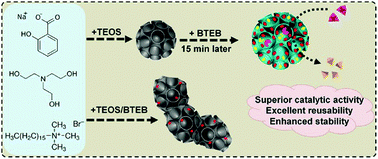Designed synthesis of organosilica nanoparticles for enzymatic biodiesel production†
Abstract
Porous nanomaterials are of great significance in enzyme immobilization by addressing the intrinsic issues of the native form of enzymes, such as low enzymatic activity and reusability. In this work, we report the successful fabrication of benzene-bridged dendritic mesoporous organosilica nanoparticles (BDMONs) with highly enriched benzene groups in the pore channel wall by a delayed addition method. The developed BDMONs were explored as nano-carriers for lipase immobilization. This platform exhibited a specific activity 6.5 times higher than that of the free enzyme with an excellent reusability, and enhanced thermal and pH stability. It is demonstrated that both the hydrophobic benzene groups and dendritic large-pores are responsible for the superior performance of the immobilized lipase in comparison with dendritic mesoporous silica nanoparticles, ethane-bridged dendritic mesoporous organosilica nanoparticles, and benzene-bridged MONs without large-pores. In particular, the designed nanobiocatalyst functions better than the free enzyme in the transesterification of corn oil to produce biodiesel, showing 93% conversion in the first cycle while retaining 94% of the initial catalytic activity after 5 cycles.

- This article is part of the themed collection: Materials Chemistry Frontiers HOT articles for 2018


 Please wait while we load your content...
Please wait while we load your content...
